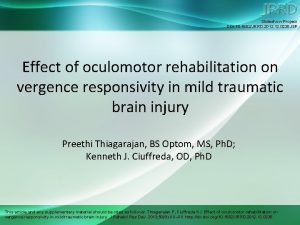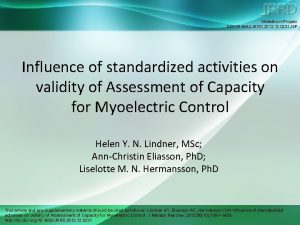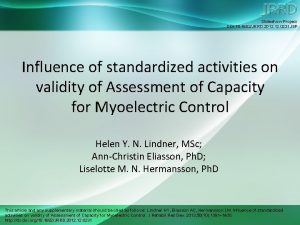Slideshow Project DOI 10 1682JRRD 2012 0027 JSP






- Slides: 6

Slideshow Project DOI: 10. 1682/JRRD. 2012. 0027 JSP Investigation of robotic-assisted tilt-table therapy for early-stage spinal cord injury rehabilitation Colm T. D. Craven, MEng. Sc; Henrik Gollee, Ph. D; Sylvie Coupaud, Ph. D; Mariel A. Purcell, MRCGP; David B. Allan, FRCS This article and any supplementary material should be cited as follows: Craven CT, Gollee H, Coupad S, Purcell MA, Allan DB. Investigation of robotic-assisted tilt-table therapy for early-stage spinal cord injury rehabilitation. J Rehabil Res Dev. 2013: 50(3): 367 -78. http: //dx. doi. org/10. 1682/JRRD. 2012. 0027

Slideshow Project DOI: 10. 1682/JRRD. 2012. 0027 JSP • Aim – Investigate physical exertion rate of robotic-assisted tilttable therapy (RATTT) in patients with spinal cord injury (SCI). – Compare response of patients with motor-complete SCI (c. SCI) and motor-incomplete SCI (i. SCI). • Relevance – RATTT may provide strong training stimulus to complement conventional physiotherapy. – RATTT may both increase orthostatic tolerance and attenuate decline in aerobic fitness. This article and any supplementary material should be cited as follows: Craven CT, Gollee H, Coupad S, Purcell MA, Allan DB. Investigation of robotic-assisted tilt-table therapy for early-stage spinal cord injury rehabilitation. J Rehabil Res Dev. 2013: 50(3): 367 -78. http: //dx. doi. org/10. 1682/JRRD. 2012. 0027

Method Slideshow Project DOI: 10. 1682/JRRD. 2012. 0027 JSP • Participants – 3 c. SCI. – 3 i. SCI. • Protocol – 5 discrete phases, 5 min each • Measures – Continuous: pulmonary gas exchange, ventilator, heart rate. – Final 30 s: blood pressure. This article and any supplementary material should be cited as follows: Craven CT, Gollee H, Coupad S, Purcell MA, Allan DB. Investigation of robotic-assisted tilt-table therapy for early-stage spinal cord injury rehabilitation. J Rehabil Res Dev. 2013: 50(3): 367 -78. http: //dx. doi. org/10. 1682/JRRD. 2012. 0027

Method Slideshow Project DOI: 10. 1682/JRRD. 2012. 0027 JSP • Testing phases: – 1. Subject supine; no stepping profile imposed. – 2. Subject tilted to 70 from horizontal at 0. 06 rad/s. – 3. Robotic orthoses provided full guidance force. • c. SCI: No volitional effort. – 4 a. i. SCI only. Guidance force reduced, volitional effort increased. – 4 b. Functional electrical stimulation (FES) applied. • i. SCI subjects instructed to continue volitional participation. This article and any supplementary material should be cited as follows: Craven CT, Gollee H, Coupad S, Purcell MA, Allan DB. Investigation of robotic-assisted tilt-table therapy for early-stage spinal cord injury rehabilitation. J Rehabil Res Dev. 2013: 50(3): 367 -78. http: //dx. doi. org/10. 1682/JRRD. 2012. 0027

Results Slideshow Project DOI: 10. 1682/JRRD. 2012. 0027 JSP • i. SCI – O 2 uptake, respiratory exchange ratio (RER), minute ventilation, heart rate: • Significantly increased in Phases 4 a and 4 b only. • c. SCI – Minute ventilation: • Small but significant increase. • i. SCI vs c. SCI – O 2 uptake, RER, minute ventilation, heart rate: • No difference in Phases 1 -3. • Significantly larger in Phase 4 b for i. SCI. – Mean arterial pressure significantly larger in all phases for i. SCI. This article and any supplementary material should be cited as follows: Craven CT, Gollee H, Coupad S, Purcell MA, Allan DB. Investigation of robotic-assisted tilt-table therapy for early-stage spinal cord injury rehabilitation. J Rehabil Res Dev. 2013: 50(3): 367 -78. http: //dx. doi. org/10. 1682/JRRD. 2012. 0027

Conclusion Slideshow Project DOI: 10. 1682/JRRD. 2012. 0027 JSP • Volitional effort led to increased cardiopulmonary and ventilatory response during RATTT. – Sustained or improved with addition of FES. • Patients with i. SCI: – Period of training with volitional contribution could improve cardiopulmonary and ventilatory fitness. • Patients with c. SCI: – FES-assisted RATTT may be sufficient to attenuate fitness losses. This article and any supplementary material should be cited as follows: Craven CT, Gollee H, Coupad S, Purcell MA, Allan DB. Investigation of robotic-assisted tilt-table therapy for early-stage spinal cord injury rehabilitation. J Rehabil Res Dev. 2013: 50(3): 367 -78. http: //dx. doi. org/10. 1682/JRRD. 2012. 0027











